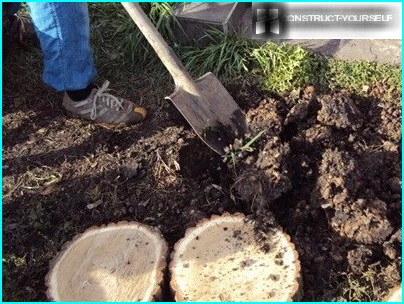
El «Queen» woods, who heads the popularity rating among the masters of landscape art. It is a sacred tree, acting talisman of the site and a powerful source of bioenergy, is valued not only for its unique healing properties, but extraordinary decoration. Needle-like foliage is emerald green, dark green and even blue shades can transform plant composition, giving a unique flavor to the landscape design of the site.
The contents
Applications of fir in landscape design
Hardly anyone can remain indifferent to luxury, color, and the frozen beauty of the needles of conifers. It is not surprising that the fir in the landscaping of the site is used quite often. She looks great as a planting container for framing garden paths and in the design of rock gardens.
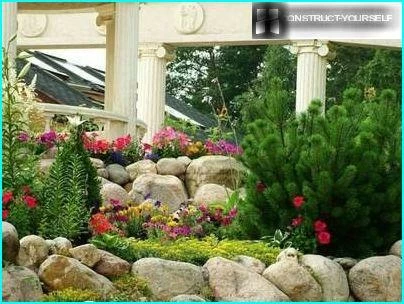
Ephedra is ideal for creating layered compositions, harmoniously combined with low shrubs and flowering perennials
Trees with needle-like foliage of rich green color interesting look in combination with bright flowers annual and perennial plants. To create songs perfectly suited: Japanese anemones, pansies, Aquilegia, Phlox and Hosta. Conifers – ideal for creating evergreen sculpture that can make the appearance of a garden richer and more colorful.
Among the main advantages of the fir in the design of the site is to provide:
- Ephedra will delight the needle saturation shades of green in the summer, does not burn out in the sun and winter, contrasting with the white snow.
- Released by the plant volatile capable to clear the air, rendering the human body healing effect.
- Spruce is great for all styles of landscape design.
- Bushy branches convenient to use when making crafts: creating paintings, herbarium specimens, Christmas songs.
But spruce, like any other plant, has its drawbacks. For example, this ephedra is able to grow strongly, dimming the area and depleting the soil. Therefore, for the design of gardens using firs with dwarf form.
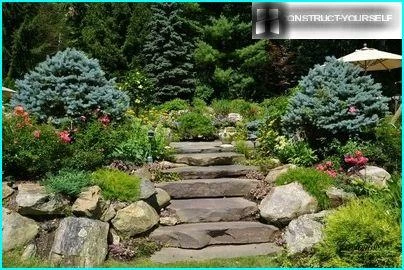
Spruce is convenient because it is easy to pruning. This giving of the crown’s unique shape, even to the experienced gardener no problems
It is advisable to plant a spruce tree along the fence. In a short span of time ephedra increases its curvy shape, and his thick legs form a solid and dense wall.
Varietal diversity of decorative forms
In modern parks and gardens more than 20 kinds of oil. The main when choosing the type of ephedra is the configuration of its crown and plant size in adulthood.
In landscape design the most widely 3 kinds of trees:
- Common – type species presented more than 50 garden forms. Established on the basis of undersized forms reach a height of 1.2 m, and average height – 3 meters or more. A wide palette of colouring of needles starting with gold and finishing with deep green, on the branches, collected in a pyramid or crown pincushion, makes the conifers of this kind of welcome in the garden plots.
- Barbed in the culture represented more than 70 varieties. Most of them are medium to tall trees up to 40 meters with a beautiful conical crown. Although there are dwarf forms up to 2 m. the Needles are very prickly: hence the name of the species. It can be bluish-white, steel-blue, silver and bluish-green.
- SIZ – has more than 20 decorative forms. The name has been thanks to ash-grey bark and bluish tint of the pine needles. Dwarf forms of this species are spherical and gnezdovoy shape of the crown, and a tall cone. Palette color needles is quite wide ranging with a yellowish-Golden and grey-blue, and finally bright green.
Eat like any plants, are divided into three groups: dwarf, medium and tall. When planting garden plots of the most popular are dwarf and medium representatives of conifers.
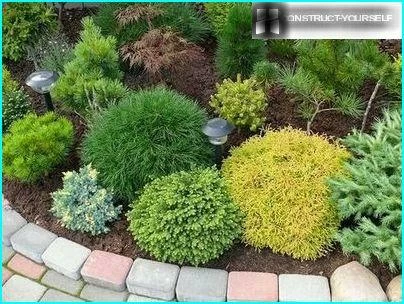
Among the variety of coniferous ornamental plants in landscaping are very popular prostrate and dwarf varieties
Dwarf varieties
Among the low-growing forms are plants whose size in adulthood in several times less in comparison with the original parent view. For example, under natural conditions spruce named as Picea abies is a 50-foot beauty with a neatly decorated crown, the width of which reaches 8-10 meters.
Decorative form of this tall ephedra, known as Picea abies «Nidiformis» or spruce «cushion», reaches two meters in height with the width of the crown is 2-3 meters.
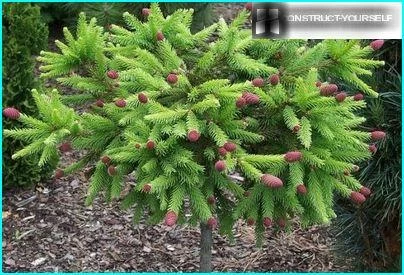
The main advantage of dwarf forms of conifers, is the minimum annual growth of young shoots, which in most cases restricted to 10-15 cm
Among modern varieties created based on Norway spruce, the most famous ornamental conifers, the crowns of which have gnezdovoy or spherical shape.
For the formation of low curbs and design of rock gardens is perfect miniature shrub Picea abies «Nidiformis».
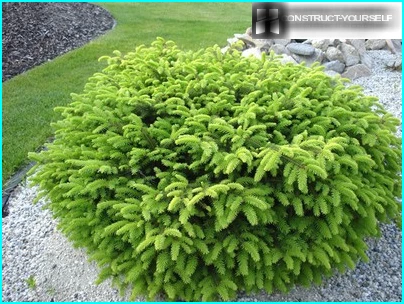
Dwarf spruce «Nidiformis» in adulthood, reaches a height of only 40 cm, forming a spreading crown with a diameter up to one meter
Located fan-shaped thin delicate shoots »Nidiformis» is decorated with soft and short needles delicate emerald hue.
No less attractive and «Little Gems». Extending from the mid-crown shoots, framed by a dark green thin needles, form a neat hemispherical «pillow». Particularly interesting it looks in a standard shape, planted in an outdoor container or pot.
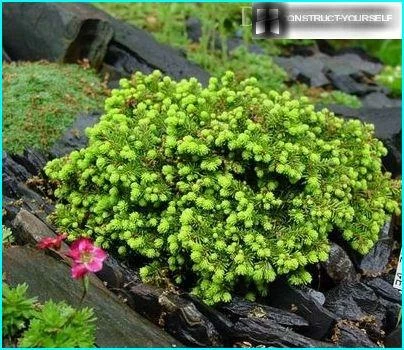
Branches miniature beauties Picea abies «Little Gem» abrase soft short needles are deep dark green hue
Beautiful ostokonechny dense crown shape is Picea abies «Will’s Zwerg». The plant is interesting due to covering milk shoots pale green shade of the young pine, which contrast against the dark green older needles. An evergreen shrub well suited for small gardens.
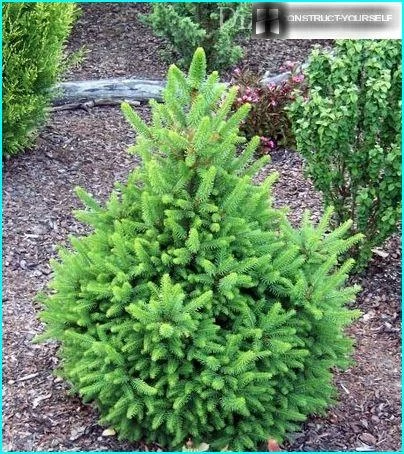
Spruce «Will’s Zwerg» it is interesting to look at the group compositions and as a tapeworm in the regeneration of the gardens a small area
Extraordinary decorative famous for bred by breeding «Glauca Of Globose». The dwarf plant has an articulated trunk. Its sprawling branches, dotted with millions of thin needles elegant silvery-blue hue form a beautiful spherical crown. Formed on the branches cones resembling Christmas decorations, give the tree a special appeal.
